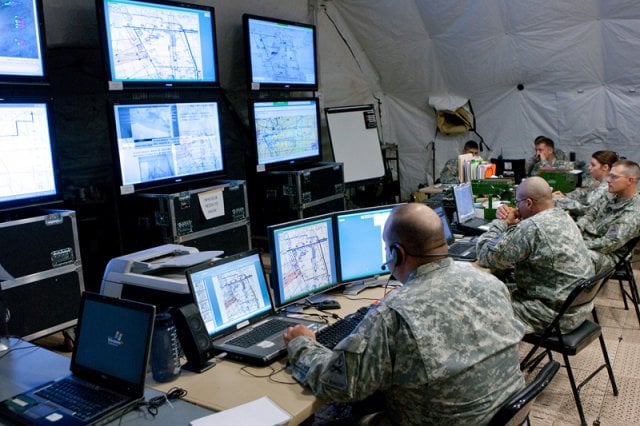
Richard Speer
ARLINGTON: The Army’s no-holds-barred study of its network shortfalls should produce a comprehensive strategy to solve them — a strategy that can withstand the scrutiny of a skeptical Congress. That’s the goal Acting Army Secretary Robert Speer laid out for me and a fellow reporter after an Association of the US Army event this week. The strategy, Speer said, must also go beyond purely technical solutions and address how the Army acquires and funds that technology.

Gen. Mark Milley
Speer is clearly focused on convincing Congress. Army officials have been giving key committees progress reports, he told us, and the Chief of Staff, Gen. Mark Milley, intends to brief the Hill on some proposed solutions before September 1st.
“We’ve got a commitment, before the summer closes out, to go back in and talk and provide them further information as to where we are. We have updated them and we will continue to update them; but we haven’t given the final solution,” Speer told us. “The Chief has made a commitment for instance to go back in to the SASC (Senate Armed Services Committee), back in the SAC (Senate Appropriations Committee), and provide them additional information – I believe the date was before the 1st of September.”
Why the focus on the Senate? Unlike the House, the Senate slashed funding for the Army’s flagship battlefield network, WIN-T, out of concern that its transmissions were too easy for an advanced adversary like Russia to detect, hack, and jam. “We’ve got to be able to tell Congress that we now have things that we’re looking (at and) what are the outcomes we’re expecting,” he said, “so we can receive resources and logically and intelligently say, ‘these are the outcomes that we expect from those resources going forward.’”

Robert Speer
“One of the criticisms the Army has had over time is ‘you don’t have a modernization strategy, you really don’t have a network strategy,’” Speer said. With the review, he said, “we know where some of the shortfalls are, and we’re now starting to develop that strategy.”
“It’s not just network,” Speer said of the strategy. “It is the other business, ‘generating force’ processes, whether it’s resourcing or acquisition, that allow us to do better.” “Generating force” is jargon for the parts of the service that don’t go to war themselves but generate combat power by training troops, developing weapons, shipping supplies, and so on.
The review started out very technical and “network centric,” Speer acknowledged, and his remarks implied — without stating it outright — that he’s having to push people to look more broadly. “I think we’ve got a lot of work to do to broaden it a little bit,” he said. “It also needs to look at and tie in better the work that’s being done in acquisition.”

Army command post. Much of the technology is identical to commercial networks, albeit often ruggedized for harsh conditions.
The Army and Industry
The Pentagon notoriously struggles with delays, cost overruns, and the whole process of acquisition — from researching new technologies fast enough, to specifying realistic performance requirements for new weapons, to buying and building those systems affordably. Information technology is particularly tricky for the military, because it advances so quickly, on a Moore’s Law cycle of 18-24 months when defense procurements take 5 to 15 years. And Army acquisition has suffered two decades of problem programs: Crusader howitzer, Comanche helicopter, Future Combat Systems, Joint Tactical Radio System, and now WIN-T.

Army WIN-T Tactical Communications Node.
Does the Army need another big “Program of Record” to fix the network, I asked, with all the risks involved, or can it do something more nimble?
“The answer to that one has to come out of the strategy,” Speer said. “Sometimes, what you get out of a program of record that goes for a big bang solution is you get a single contract(or) solution that’s not going to fit. Private industry right now is moving much faster… and we can’t build a proprietary solution.”
A proprietary solution is one where a single contractor owns the rights to a technology and other companies are effectively barred from working on it. Instead, the Army – and the armed services in general – are trying to move to an open architecture approach where any vendor can participate, as long as their product meets certain standards known to all. This shift can be uncomfortable for both for the Pentagon bureaucracy and for defense contractors’ bottom lines.
That’s why the Army is now reaching out to industry, with Gen. Milley personally taking the lead. “We’ve got to allow them to come in (and) help us solve the common operating environment, come up with solutions that we can buy and replace fairly quickly when need be with new technology that fits into the network,” Speer said.
“There’s going to be a little bit of a trust factor there,” Speer said of industry. “For the most part, I believe, the feedback’s been positive. There was initially a little bit of skepticism as to what we were trying to do.”
Given that WIN-T was the Army’s primary network project for years and is now being questioned – although, Speer emphasized, “we’re not throwing WIN-T out – contractors won’t commit until they’re confident the Army and Congress won’t change their minds again. “They want a commitment to be able see where we’re going,” Speer said. “That gets into asking for the resources, showing where the resources are placed against.”
That bottom line, of course, brings everything right back to the people with the power of the purse: Congress.
Army eyes TBI monitoring, wearable tech for soldiers in high-risk billets
“We are also looking at what additional personal protective equipment we can provide to our folks, especially instructors and others who are routinely exposed to blast pressure,” said Army Secretary Christine Wormuth.


























